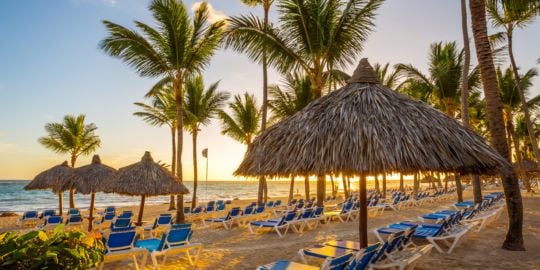One huge problem with the water is that it has created a major problem with a glut of plastic bottles everywhere. Glass beer bottles can be recycled, but those plastic water and soda bottles are thrown away by the millions and there is nowhere for them to go except into the streams and out to sea.
Last July, there was a torrential rainstorm in Barahona. The city is built on a slope, The streets are built on something like a gridiron pattern. There are some underground sewers that run under streets close to the center of the city, but most drainage involves gutters on both sides of the streets, where the middle part of the street is paved with asphalt, and refuse like bottles end up in the gutters, waiting for the next rainfall to wash them down the hill,.
It started to rain about noon,and within an hour all the motos and pasolas that dared to travel down 30 de marzo street flooded out. In another hour, the water came through the gutters with such force that the sewer grate became a geyser , with water gushing three feet into the air. The street was often so cluttered with bottles, jugs, and plastic grocery bags that you could not see between them. I was sitting in a Loncheria about two blocks from my hotel, which was maybe four feet higher than 30 de marzo. At the peak of the flood, there was about 6 inches of water in the shop. The bottles were traveling down the street, which runs parallel to the coast at around 15 miles per hour. When they reached the corner, they turned right and went speeding down toward the Malecon. At 4:00 PM the rain tapered off,and after 6:00 PM the water was no longer flowing down the street.
There is a long peninsula called El Cayo that extends in front of the harbor and parallel to the Malecon past the tall smokestack of the Sugar mill. There is a beach on either side of El Cayo. The side facing the Malecon is sandy and mostly free of clutter, and on sunny days there are always some people swimming in the bay. The side of El Cayo that faces the Caribbean is littered ankle to knee deep in trash that has floated up on the beach, most of it consists of empty plastic bottles. Like most of the SW coast, the beach is mostly small pebbles and the ocean is rather rough, though less so than in Paraiso. Paraiso has a lot more trash on its rocky beaches than the name might suggest. The beautiful thing about Paraiso is that the ocean facing the town is several impressive shades of blue: azure, teal, turquoise and indigo
Drinking water is also sold in plastic bags with the brand name Everest. A bag is about 9 oz and costs 2 pesos at the colmados. Clear plastic bottles cost at least 10 pesos and hold 12 oz. The bags are also litter, but take up a lot less space and do not seem to wash up on the beaches.Recently there was an article in the Ecos del Sur blog, that passes for a local newspaper, that a company has announced plans to gather up and recycle the bottles. I hope they go through with this.
Rainy season In Barahona
Nice description. Waste and garbage are an issue all over this country. We all hope that the "plans" to open recycling factories actually come together. Personally I am working with 2 clients - their interest is in recycling!
what we need is some government interest! We need encouragement and we may need laws to change how people handle recycling and and garbage in general. OF course we also need a major re education on these issues!
I always pick up all the bottles around me and pitch them into the nearest zafacon. I encourage those I know to buy the water in bags rather than bottles. Here in Miami, Publix turns those plastic grocery bags into 2×4's that make nice fences and less nice park benches (they tend to sag in the heat after a few years). Barahona has about 70,000 people and is spread out over the hills sloping down to the bay, and the streets seem to channel the water coming from the east of town down to the Parque Central. The town was mostly planned out by the English back in the times of the "Danza de los millones" (sugar boom) in the 1920's, and greatly resembles Belize, expect that Belize is on very low ground and the houses are built on stilts. In Belize the plan was to throw your trash in the gutter, and high tide and storms would wash it into the ocean. It does not work all that well. Barahona has a mixture of cement block houses and coconut slat houses, mostly with galvanized steel "zinc" roofs. They recently repainted and fixed up the Parque Central by trimming the trees into sort of cylindrical umbrella shapes and repainting the bandbox in the center. In letters around the top it reads LUIS E DELMONTE A BARAHONA MCMXXVII. They started in July and seem to have finished the job around the end of February. There was a sort of African-looking statue about three feet high that I suspect is some version of Le Baron Samedi that was occasionally rewarded with a pink shawl that was removed in February. Another yellow idol about two feet tall, was undisturbed. There are three newer similar parks scattered about town. I think the latter is a Taino deity.
There are quite a few Haitians in Barahona and they seem to get along pretty well with the Dominicans. I imagine that the statue may have been put there by one of them. None of my Dominican friends seem to know anything about vodun, santeria, Congo, Palo mayombe, macumba or any of the syncretic afro-caribbean religions. I suspect that Trujillo and the invasions of Haitians had a lot to do with this.
Barahona has an air of tropical decadence about it that you don't see in other parts of the country. On weekends, the Malecon teems with motos and pasolas as well as all sorts of other vehicles. There are a lot of open air bars playing merengue farther into the night than I have ever stayed up for.
Hi..your inbox is full
My inbox is full?
What does that mean?
What should I do about it?
Check your messages and delete some to give you some "space" for new ones.
Bob K
There were two short messages.
I deleted one and answered another









